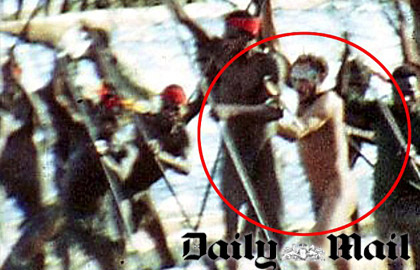AGAMEMNON FILMS



TCaptured on a small cine-camera as it plays across the ranks of 17 approaching cannibal war canoes, the image is fleeting but unmistakable.
Among the massed ranks of dark-skinned headhunter tribesmen heading around the bend of a New Guinea river is a naked and bearded white-skinned man, his face partly covered in war paint as he paddles furiously.
The appearance of a white face among a throng of Papuan cannibals would be astonishing at the best of times. But in the circumstances in which this footage was shot, it is potentially mind-boggling.
For the impressive scene was filmed in 1969 close to the spot where, eight years earlier, a scion of the Rockefeller dynasty — the richest, most powerful family in U.S. history — had gone missing, sparking the biggest hunt ever launched in the South Pacific.
Since 23-year-old Michael Rockefeller disappeared during a trip to collect primitive art from one of the remotest corners of the planet, rumours swirled about his fate.
The official explanation advanced by the former colony’s Dutch rulers was that he drowned after he tried to swim to shore from his capsized boat. Others insisted he met a more horrible fate — killed and eaten by cannibals seeking revenge on white men for a Dutch attack on their village.
Now, a documentary made by Fraser Heston, son of actor Charlton Heston, has thrown the focus on this extraordinary story once more. And, tantalisingly, newly unearthed film footage of the mysterious white canoeist suggests an astonishing possibility. Instead of being killed and eaten, did the Harvard-educated American reject his civilised past and join a tribe of cannibals?
The riddle started in 1961 when the young graduate swapped his entitled Manhattan life for the privations of Dutch New Guinea. Now part of the Indonesian province of Papua, it was one of the wildest, most remote places on Earth, populated by people largely stuck in the Stone Age.
A keen anthropologist, Rockefeller wanted to supply his father Nelson — governor of New York and later Gerald Ford’s Vice-President — with exhibits for a museum of primitive art he had just founded.
Occupying 10,000 square miles of jungle swamp on the southern coast of the Dutch colony, the Asmat tribes were ferocious headhunters, but they also made stunning wooden sculptures (rubbed with the blood of those they killed) as well as hauntingly beautiful decorated skulls. These they collected from tribal foes, having eaten their brains in a sacred ritual they believed would give them the dead men’s power.
Their bloodthirsty way of life revolved around endless revenge attacks against neighbouring villages. Each time a tribe member was killed, he had to be avenged by taking the skull of an enemy — whether man, woman or child.
Whites were generally safe from this tribal war, and Rockefeller spent six months there, writing home about the amazing art he had acquired and his fascination with Asmat culture. His father later said his restless son had never been happier. But things were about to change for ever.
On November 17, 1961, Rockefeller was travelling up the coast — a region of dense rainforest, mangrove swamp and crocodile-infested mudflats known as the Land of Lapping Death — when his small catamaran capsized in rough seas.
Two teenage native guides immediately swam towards shore — around nine miles — to get help.
Following a very uncomfortable night spent clinging to the submerged craft, an impatient Rockefeller stripped to his underpants, strapped together two jerry cans for buoyancy and struck out for land, telling his companion, a Dutch anthropologist: ‘I think I can make it.’
They were the last words he is known to have uttered.
The Dutchman was picked up the next day, but his companion was never seen again
.The hunt was exhaustive. His father chartered a Boeing 707 and flew a media army out to the region. Thousands of locals joined a search involving dozens of ships, planes and helicopters. But no trace was ever found, and after ten days his devastated father gave up.
Dutch officials presumed that Rockefeller had drowned.
But he had been a strong swimmer, the sea was calm, the tide was pushing him to shore and the local sharks weren’t man-eaters.
Rumours persisted that he had reached land. Then, in 1968, New York magazine editor Milt Machlin flew out to Papua and launched a months-long search. He discovered a retired Dutch missionary, Cornelius van Kessel, who had been living in the Asmat area when Rockefeller disappeared.
The priest told Machlin an extraordinary story: a week after the last searchers gave up, he started hearing tribal rumours that the American had been caught and killed.
The reason, he claimed, was that three years before Rockefeller disappeared, a Dutch police patrol had come to a village called Otsjanep to sort out a tribal headhunting war. Fearing they were about to be attacked, the police opened fire, killing five village leaders.
By their sacred code, the tribe had to have revenge and take a head — a white man’s head like that of the patrol’s Dutch leader.
That was easier said than done. Then, one day, a group of some 50 Otsjanep men were returning home from a trading trip when they finally got their chance: a white man, exhausted and unarmed, swam towards their canoes just offshore.
One of the tribesmen was said to have stabbed him fatally with a 10ft fishing spear, before they hauled him into a boat and took him to shore, where they chopped him up, cooked him and ate him.
The priest said the tribesmen admitted they had killed him as revenge for the police raid.
Dutch officials disputed the story, saying that missionaries were unreliable. Besides, sneered one sceptic, an even more bizarre story had leaked out, that Rockefeller was still alive, and ‘kept as a white idol by a tribe near the coast’.
So what was the truth?